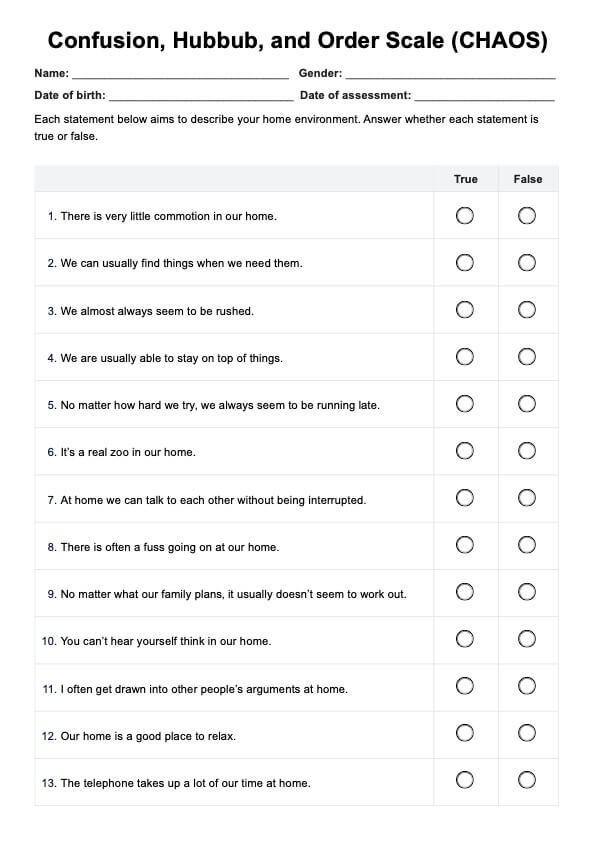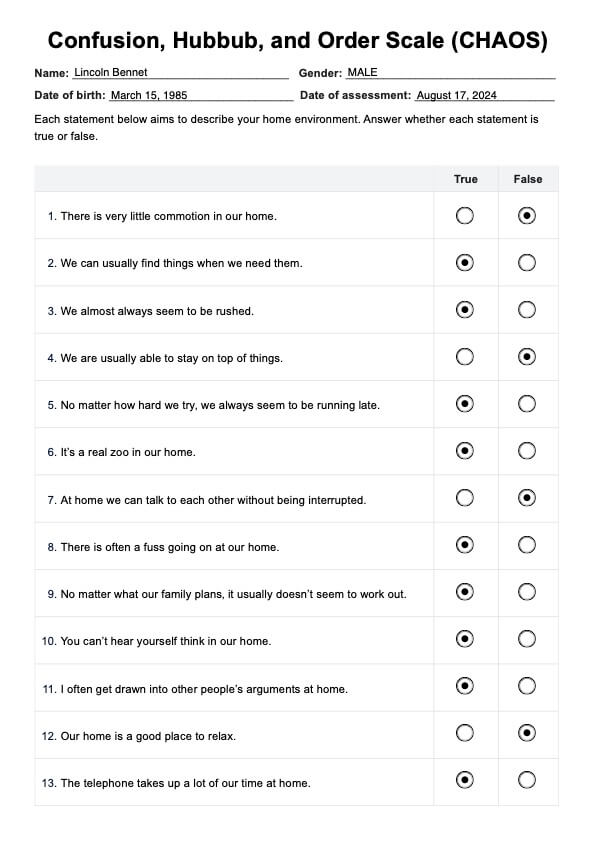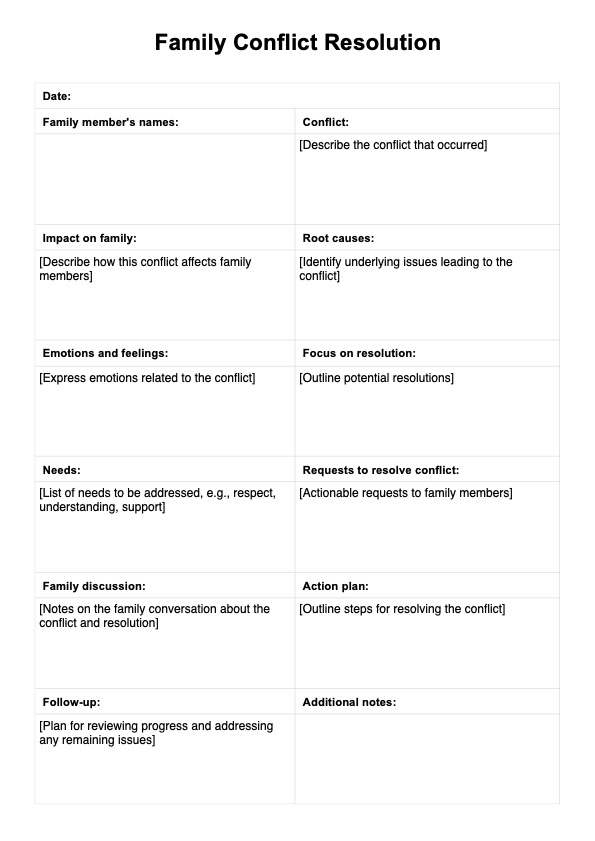CHAOS Scale
Learn about the CHAOS scale, including examples and how to use it effectively. Download Carepatron's free PDF guide for reference.


What is the Confusion, Hubbub, and Order Scale (CHAOS Scale)?
The Confusion, Hubbub, and Order Scale (CHAOS Scale) is a widely used tool in applied developmental psychology. It is designed to measure the level of environmental confusion and disorder within a home environment. This scale provides insight into household chaos, which can significantly influence early childhood development and various health risk behaviors. The CHAOS Scale focuses on capturing the frequency and intensity of disruptions, noise, and general disorder in a household, often called the home traffic pattern.
The Confusion, Hubbub, and Order Scale has demonstrated satisfactory internal consistency, making it reliable in research and practical applications (Shamama-tus-Sabah & Gilani, 2010). High CHAOS scores typically indicate a chaotic environment with frequent interruptions, noise, and very little commotion control, which can adversely affect both children and adults living in such settings. On the other hand, lower CHAOS scores suggest a more orderly and predictable home environment, where routines are stable and disturbances are minimal.
The CHAOS Scale is essential for understanding how environmental processes impact parental behaviors and child development. A chaotic home environment can lead to increased stress and may negatively affect children's cognitive and emotional outcomes. By assessing the level of household chaos, the Confusion, Hubbub, and Order Scale helps identify homes where interventions might be needed to reduce disorder and promote a healthier developmental setting.
CHAOS Scale Template
CHAOS Scale Example
How to use our CHAOS Scale template
Using the CHAOS Scale template is straightforward. This easy-to-use tool helps in identifying environmental factors that may impact health and developmental outcomes. Below are the steps to effectively utilize our CHAOS Scale template:
Access and download the template
To get started, visit Carepatron's platform and search for the CHAOS Scale template. Once located, download the template to your device. This user-friendly document is available in various formats, allowing you to choose the one that best suits your needs. Ensure that you have the latest version to benefit from any recent updates or improvements, ensuring accurate and reliable assessments.
Review the template content
Before using the CHAOS Scale template with patients, take a few moments to review its content. Familiarize yourself with the scale's questions and the overall structure to ensure you understand what each section aims to assess. This review will help you guide patients through the process smoothly, addressing any questions or concerns while ensuring that the assessment accurately reflects their home environment.
Introduce the template to the patient
When introducing the CHAOS Scale to a patient, explain its purpose and how it can provide insights into their home environment's influence on their health. Encourage honesty and openness, as the accuracy of the CHAOS scores depends on their genuine responses. Reassure them that the information gathered will be used to enhance their care and address any health risk behaviors linked to household chaos.
Use the template for assessment
During the assessment, guide the patient through each section of the CHAOS template. Ensure that they understand each question and provide adequate time for thoughtful responses. Use the completed template to evaluate the level of household chaos, focusing on key areas like environmental confusion and home traffic patterns.
Scoring and interpretation
The Confusion, Hubbub, and Order Scale (CHAOS) is a valuable tool for assessing the level of environmental confusion in a household. Its scoring method is easy to understand, yet it requires careful attention to reverse-scored items.
Each item on the scale is scored as either 0 or 1 point. For most items, a "true" response earns 1 point. However, seven items (1, 2, 4, 7, 12, 14, and 15) are reverse-scored. For these items, a "false" response earns 1 point. Then, sum all points to obtain the total score.
The CHAOS Scale operates on a continuum, with higher scores indicating a more chaotic home environment and lower scores suggesting a more organized and calm setting.
Next steps after using the CHAOS Scale
After using the CHAOS Scale, the next steps involve interpreting the results to guide further action. The psychometric characteristics of the CHAOS Scale offer valuable insights into the level of disorder in home environments, which can significantly influence parental behaviors and child development. If the CHAOS scores suggest a high level of household chaos, it may be beneficial to pursue additional assessments, such as a home stimulation inventory or directly observed measures. These tools can provide a more comprehensive understanding of the environmental factors at play.
For an economical measure of home chaos, consider comparing the CHAOS Scale results with those from a separate sample to identify patterns or trends in the data. This comparison can help determine if the home environment requires intervention. It’s also important to consider other factors that may contribute to the home’s chaotic nature, such as parents reported stress levels, other people's arguments within the household, or external pressures.
Based on the findings, healthcare professionals can recommend strategies to reduce household chaos, improve the home environment, and support healthier parental behaviors. By addressing these factors, you can create a more nurturing and stable environment that promotes better outcomes for both children and adults.
Reference
Shamama-tus-Sabah, S. & Gilani, N. (2010). Household chaos and its association with maternal education, family system, and children’s academic achievement in Pakistani culture. Pakistan Journal of Psychological Research, 19–30.
Commonly asked questions
The CHAOS Scale is a tool used to assess the level of confusion, disorganization, and noise in a home environment, which can impact health and developmental outcomes. It is commonly used in research and clinical settings to understand the influence of household chaos on well-being.
Aiming for a lower score on the CHAOS Scale is ideal, as it indicates a more orderly and calm home environment. A lower score is associated with reduced stress and better overall health and developmental outcomes.
The CHAOS Scale measures environmental confusion, disorganization, and noise within a household. It captures how these factors contribute to the home's overall sense of order or disorder.





















-template.jpg)


















































































